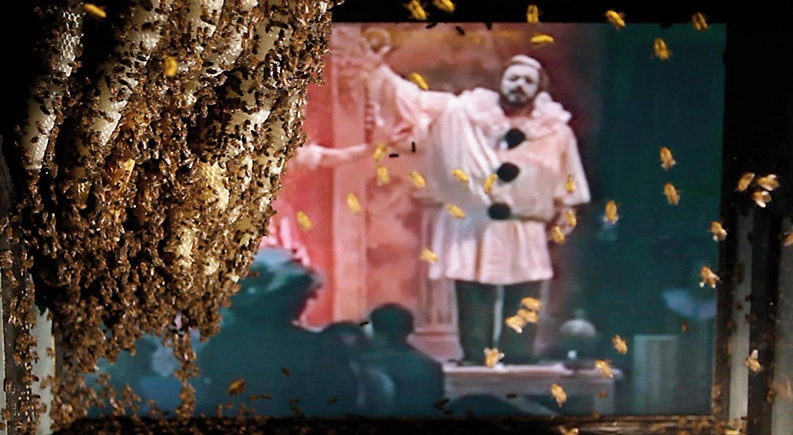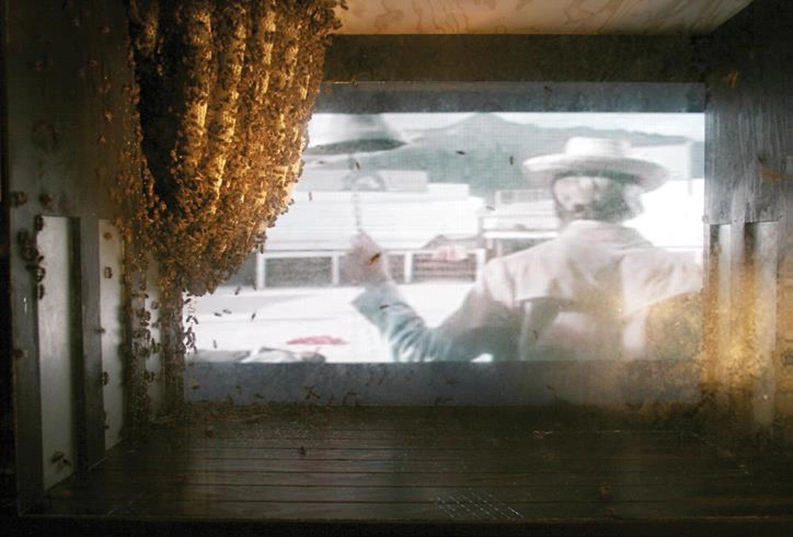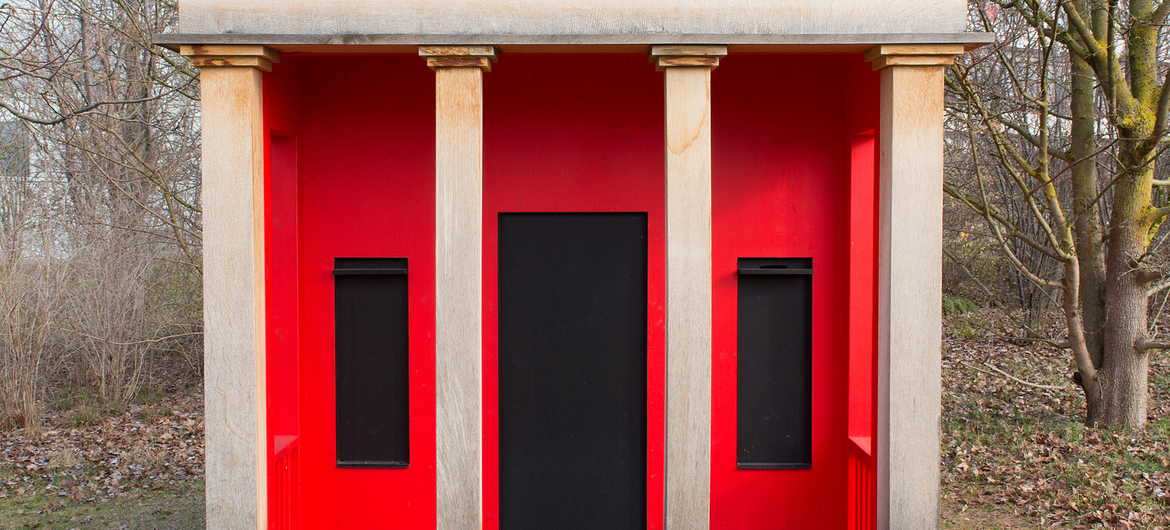Year: 2009
Material/Technique: Wood, paint, multimedia installation, bees
Dimensions: 246 x 250 x 330 cm.
The Bee Opera is a wooden palace for a swarm of honeybees in bonsai format. Peter Regli designed the prototype in 2009 for a workshop at Bern University of the Arts (HDK) and showed it that same year at «Utopics», the 11th plastics exhibition in Biel. The newly constructed final version of the weatherproof Bee Opera has been installed in the south park of Novartis Campus in 2012.

The Bee Opera, registered as RH (reality Hacking) No. 272, has an architectural syntax that clearly betrays its historical precedents: the classical antique portico, Andrea Palladio and the 19th-century architecture of the Wild West. The bees enter the opera house through a slit in the wall of the portico while opera goers, three or at most four people at a time, enter through a door at the back of the building. Once inside, they face a kind of puppet theatre, a flat screen on the wall showing parts of videos. The curtain is created by the bees as they build their honeycombs, but both bees and spectators are protected by a pane of glass that separates the stage from the orchestra. The bees are actors in their opera house. To the music of Ennio Morricone, they share the stage with the greats of the Spaghetti Western, with Charles Bronson, Clint Eastwood and Franco Nero. They play their part in animated films; they accompany Angela Gheorghiu singing the Casta Diva aria from Bellini’s Norma. They support Maria Callas when she sings J.S. Bach’s Ave Maria and Luciano Pavarotti when he belts out «No, pagliaccio non son!» in Leoncavallo’s Pagliacci. As stars of the stage, the bees in the Bee Opera are obviously permitted to keep their honey. They hoard it to feed themselves in winter.

Artist
Born in 1959 in Andermatt, Regli studied at the Zurich University of the Arts. He is best known for his ongoing project, Reality Hacking, a series of temporary and often anonymous interventions in the landscape and other public spaces. The main goal of the project is to challenge the pre-established perception of particular systems by performing a series of bright and uncommon interventions. Working in a various mediums including sculptures, photographs and spatial installations, Regli’s artworks are characterised by a keen observational talent and striking wit. Exploring the poetics of predictability and the obviousness of everyday objects, Peter finds inspiration in external space, so his interventions can take many forms spanning from subtle alterations to the surrealistic confrontation.
Some of his works feature objects set up in removed places including deserts or lakes where they may be seen only by rare passersby. Others are located in the crowded urban areas, but all of the Regli’s pieces briefly award a sacred status to selected, unusual sites. Reality Hacking project consists more than 320 installations to date, located all over Europe, Asia, North America and Africa, and recorded on Peter Regli’s site. Some of them include RH No. 200 (2002), an artificial island in the shape of donuts, built at the delta of a river in Switzerland using rocks and earth from the construction materials of a tunnel located nearby, RH No. 202 (2002–2003), a composition performed by the Ensemble for New Music Zurich based on a recorded soundscape the artist made of a glass shelf filled with crystal objects crashing down a flight of stairs, and played for the first time live for an audience at the Centre d’Art Contemporain in Geneva on July 2011. RH No. 222 (2005) is installation made of a tree and 5 Buddhas carved in white marble in the courtyard of the PricewaterhouseCoopers office building in Zurich with each figure connected to a hidden loudspeaker set on a timer producing laughter for two minutes.
Regli’s work is included in many important international public and private collections, including the Kunsthaus Zurich, the Federal Office of Culture, Bern, the Fotomuseum Winterthur, and the Migros Museum für Gegenwartskunst, Zurich. He lives and works in New York.
